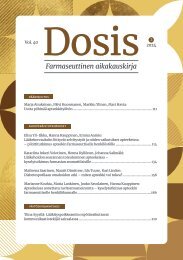Maintworld Magazine 3/2021
- maintenance & asset management
- maintenance & asset management
You also want an ePaper? Increase the reach of your titles
YUMPU automatically turns print PDFs into web optimized ePapers that Google loves.
CASE STUDY<br />
Four levels of success.<br />
questions people will not complete the<br />
survey. If the information you request is<br />
difficult to access, once again, people will<br />
not complete the survey. However, with<br />
1.000 responses, we felt we had good<br />
information to work with.<br />
What is reliability success?<br />
The first challenge was to measure<br />
“success” - what is the definition of a<br />
successful reliability program? In an ideal<br />
world, we would receive detailed financial<br />
information about production output,<br />
maintenance costs, asset value, and<br />
other key information, and we would be<br />
able to normalize it against industry type<br />
– and we would be able to measure the<br />
contribution that reliability improvement<br />
made to those results.. However, as you<br />
may imagine, too few people have that<br />
information, and even fewer are willing<br />
(or able) to share it.<br />
Instead, we chose to go with three<br />
metrics: maintenance cost as a percentage<br />
of asset value, equipment availability,<br />
and the percentage of reactive maintenance.<br />
As it turned out, the information<br />
we received on the first metric was either<br />
unreliable or too few respondents were<br />
able to provide that information. Instead,<br />
we combined the other two metrics so<br />
that we had four levels of success, as<br />
illustrated above.<br />
Our next challenge was to analyze the<br />
data and attempt to determine what the<br />
people in Group 1 did differently to the<br />
other groups. We asked questions about<br />
training, the techniques they use to<br />
develop their reliability strategy, the age<br />
of the program, the software and instrumentation<br />
they used, and many other<br />
factors. But what appeared to come from<br />
the survey was that the programs with<br />
the best culture achieve the best results.<br />
The programs with the strongest management<br />
support had the best culture.<br />
And the programs that developed the<br />
financial business case had the strongest<br />
management support.<br />
Our conclusion, therefore, was that<br />
developing a business case was one of the<br />
root causes of program success.<br />
Do surveys and correlation<br />
prove anything?<br />
Stepping back for a second, it is fair to say<br />
that it can be challenging to distinguish<br />
between causation and correlation.<br />
As I like to point out, global warming is<br />
statistically correlated with the number<br />
of pirates in the world. As the number<br />
of pirates has steadily decreased, the<br />
temperature of the globe has steadily<br />
increased, as illustrated on the next page.<br />
There is a mathematical correlation.<br />
But I think most people would agree that<br />
the size of the population of pirates has<br />
had little to do with global warming.<br />
And thus, it is the same with the<br />
author’s interpretation of the survey results.<br />
Can I say, categorically, that it was<br />
the existence of the business case that<br />
resulted in achieving the support of senior<br />
management? I expected that to be<br />
the case, therefore I may be guilty of<br />
confirmation bias. But a close examination<br />
of the data showed that 95% of the organizations<br />
that have a business case also had<br />
strong senior management support.<br />
It is also true that there may be<br />
other reasons why an organization had<br />
a culture that supported the concept of<br />
reliability improvement. But we did find<br />
that 96% of the organizations that either<br />
had strong or moderate senior management<br />
support had the right culture.<br />
And finally, it is also difficult to prove,<br />
without a doubt, that the nature of the<br />
culture influenced the success achieved<br />
by the reliability improvement program.<br />
But approximately 90 percent of the<br />
organizations in Group 1 reported:<br />
• Everyone understands the benefits<br />
[86%]<br />
• Everyone is encouraged to provide<br />
suggestions for improvement [90%]<br />
• Everyone understands the mission<br />
[95%]<br />
• Everyone is actively engaged [90%]<br />
As mentioned earlier, we examined other<br />
factors, mostly technical, but none of them<br />
achieved the high percentages listed above.<br />
As the owner of an international training<br />
organization, I was disappointed to learn<br />
that the level of training and certification<br />
did not strongly correlate with program<br />
success. Fifty percent of Group 1 and 2 said<br />
they had strong training, skills, and certification<br />
while another 40 percent said they<br />
had “somewhat strong” training, skills, and<br />
certification.<br />
3/<strong>2021</strong> maintworld 7

















